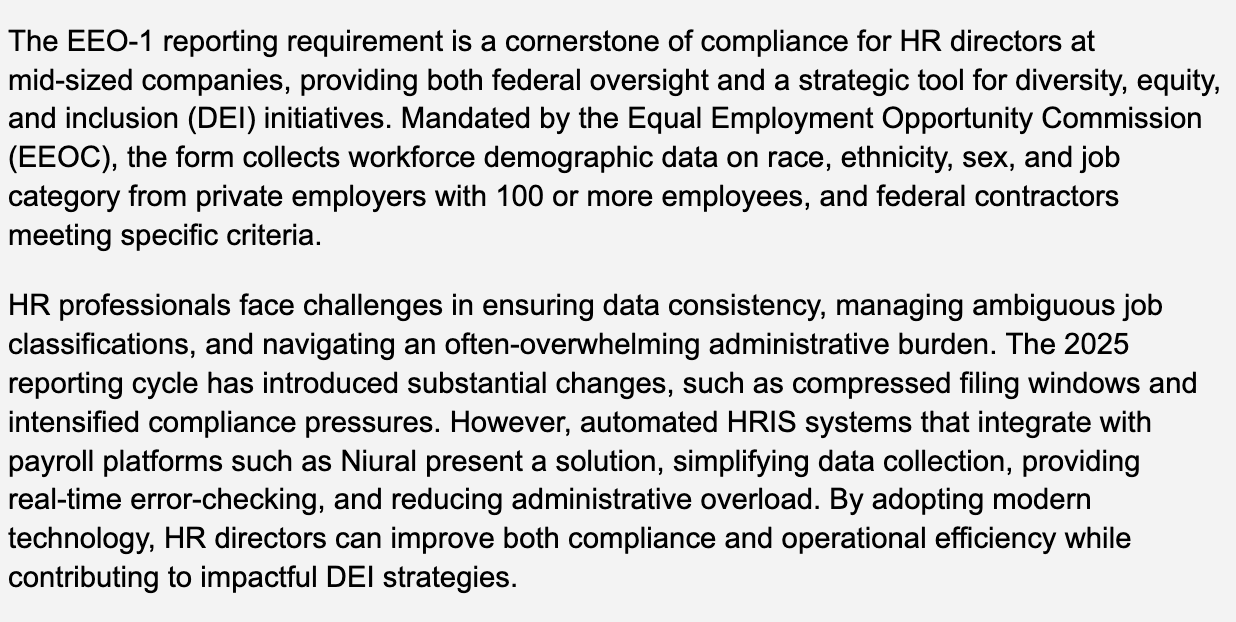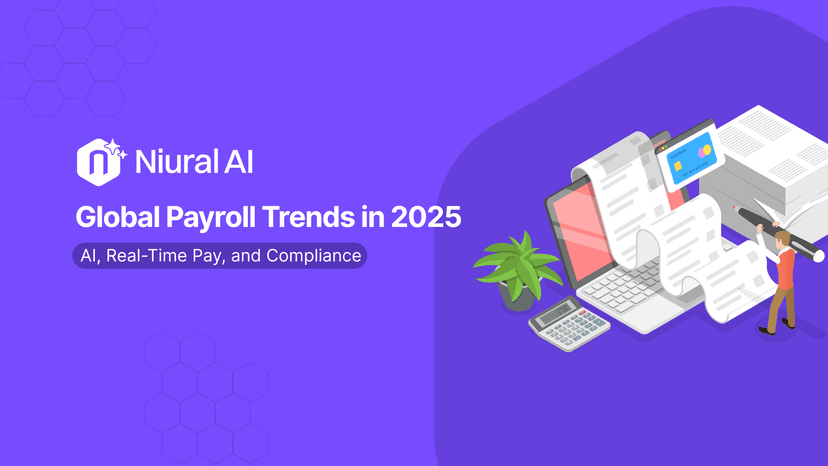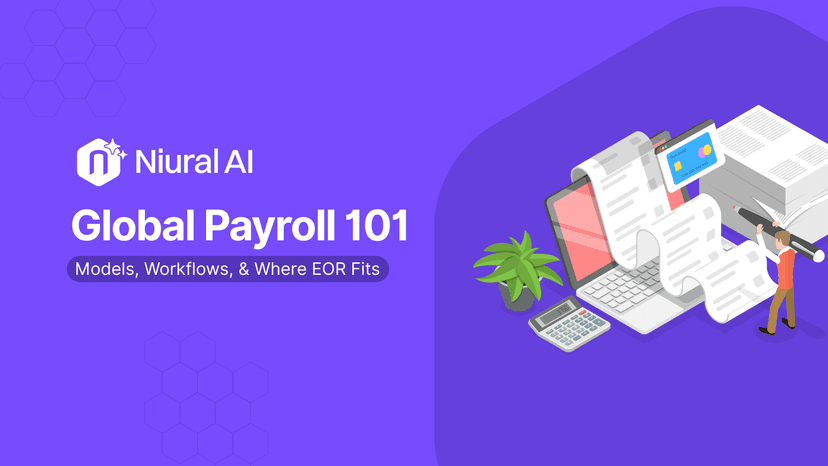Executive Summary

EEO-1 reporting is a critical compliance obligation that impacts HR Directors at mid-sized companies, particularly those navigating the complex regulatory environment of 2025. Officially known as the Employer Information Report, the EEO-1 is a tool for monitoring workplace discrimination and ensuring adherence to federal laws related to diversity and inclusion. Accurate reporting has broader implications, helping companies assess and improve their DEI efforts.
For companies, EEO-1 compliance is more than just meeting regulatory standards; it also supports strategic goals in diversity and inclusion, essential for maintaining a competitive advantage in today's workforce. In 2025, heightened regulatory changes, such as compressed submission windows, have created new challenges. Despite these obstacles, HR leaders can leverage modern tools to support both compliance and progress toward meaningful diversity initiatives.
What is EEO-1 Reporting?
The EEO-1 form, formally known as Standard Form 100, is used by the EEOC to collect data about the composition of U.S. workforces. Its primary purpose is to help enforce anti-discrimination laws and evaluate company compliance with federal mandates regarding workplace diversity and inclusion.
Recent Updates to EEO-1 in 2025
The 2025 cycle has seen pivotal changes:
- Binary-only sex reporting (male/female) per the 2024 EEO-1 Component 1 Instruction Booklet.
- A shortened filing window (May 20 to June 24, 2025) for 2024 data, increasing deadline pressure on HR teams. Employers can expect to file their 2025 workforce demographic data during the EEO-1 reporting cycle in mid-2026 with a similar submission window.
These changes make it even more crucial for HR professionals to stay abreast of regulations and utilize modern tools to ensure accurate and timely submissions.
Heads-up on race/ethnicity standards: The federal government has adopted revised OMB race/ethnicity standards (including a Middle Eastern or North African category) across many forms. While not yet implemented in EEO-1 Component 1, organizations should monitor updates so internal systems are future-ready.

EEO-1 reporting enforces anti-discrimination laws and ensures compliance with workplace diversity and inclusion mandates. (Source: Pexels)
Understanding the EEO-1 Categories and Reporting Process
Categories to Report
- Race/Ethnicity: Accurate self-identification by employees is essential for consistent reporting. The categories span multiple racial and ethnic groups and require HR teams to manage these designations carefully. The seven categories are:
- Hispanic or Latino
- Black or African American
- Asian
- White
- American Indian or Alaska Native
- Native Hawaiian or Other Pacific Islander
- Two or More Races.
- Gender: Under the current 2024 EEO-1 Component 1 instructions, employees must be reported as male or female. Companies may still track broader gender identity internally for DEI.
- Job Classifications: Each employee is categorized based on their primary responsibilities, not job titles. Categories like Technicians and Craft Workers are often subject to interpretation, and HR professionals must carefully analyze employees’ duties to assign the appropriate classifications. The report categorizes employees into ten groups:
- Executive/Senior Level Officials and Managers
- First/Mid-Level Officials and Managers
- Professionals
- Technicians
- Sales Workers
- Administrative Support Workers
- Craft Workers
- Operatives
- Laborers and Helpers
- Service Workers
The Reporting Process
The EEO-1 report is filed through the EEOC's Online Filing System (OFS), with a data collection period defined by the Workforce Snapshot. HR professionals must:
- Collect demographic data through voluntary self-identification or visual observation.
- Review each employee’s primary job classification to ensure accurate categorization.
- Submit the completed data through the EEOC’s online portal.
The process demands accuracy and thoroughness, requiring HR Directors to ensure that all employee data is both consistent and complete before submission.
Challenges HR Leaders Face with EEO-1 Reporting
Common Reporting Obstacles
- Data Inconsistencies: Discrepancies between systems (HRIS, payroll, timekeeping) are common. These must be reconciled to ensure accuracy.
- Employee Misclassification: Ambiguities in job classification can lead to improper categorization. This becomes more challenging when an organization operates across multiple locations or sectors.
- Administrative Overload: The data collection process can be time-consuming, particularly for HR Directors managing diverse workforces. In addition, state-specific compliance issues may further complicate the process, with different jurisdictions imposing additional reporting requirements.
State-Specific Compliance Issues
Mid-sized companies with multi-state operations must navigate a patchwork of regulations that complicate the federal EEO-1 process. Jurisdictional inconsistencies in race, ethnicity, or sex reporting increase challenges and require close attention to each state’s specific rules. For example, California Pay Data Reporting and Illinois EPRC (Equal Pay Registration Certificate) introduce additional state-level obligations.

Maintaining accurate data is crucial when filing the EEO-1, and HRIS tools like Niural provide valuable support to ensure precision and compliance.
Best Practices for Efficient EEO-1 Reporting
Automating Data Collection
HR software solutions that integrate effortlessly with payroll and timekeeping systems are crucial for minimizing manual work and avoiding common reporting errors. Automation facilitates consistent, accurate data collection, reducing the risk of mistakes.
Compliance Checklists and Cross-System Integration
HR leaders should adopt checklists that align with EEO-1 requirements to ensure all necessary data is gathered and correctly categorized. Integration of HRIS, payroll, and compliance systems optimizes this process and reduces the chance of discrepancies across platforms.
Ensuring Accuracy and Reducing Risk
Periodic internal audits help identify discrepancies early. HR teams should establish regular reviews of employee classifications to ensure they remain accurate as roles evolve or organizational structures change.
Impact of EEO-1 Reporting on DEI Initiatives
EEO-1 reporting not only meets regulatory requirements but also serves as a powerful tool for assessing and driving DEI progress.
The Role of EEO-1 Data in DEI Programs
The data captured in the EEO-1 report provides insight into workforce diversity, helping HR leaders identify areas that need focus. Trend analysis over time can inform targeted DEI strategies, ensuring that organizational goals are aligned with diversity objectives.
Addressing Pay Equity
While the EEO-1 does not include salary data, the demographic breakdown can be used to analyze compensation equity, identifying potential pay gaps and prompting corrective actions.
Technological Solutions for EEO-1 Reporting
HRIS platforms like Niural, which integrate with payroll systems, can automate and optimize the entire EEO-1 process, from data collection to generating reports. Niural automates data preparation and validation, and generates EEOC-ready reports for submission.
How Niural helps:
- Single source of truth: Unifies HRIS + payroll + time so headcounts, job categories, and demographic fields stay consistent across systems.
- EEO-1 Pre-Check: Niural’s AI co-worker, EMMA, can highlight missing self-ID, misaligned job families, establishment roll-ups, and snapshot date selection. It supports compliance by catching issues before export.
- Multi-entity, multi-state: Handles establishment-level reporting
- Auditability: Role-based approvals and audit trails for edits to sex/race/job category.
- Measured outcomes: Teams typically cut prep time from weeks to days and reduce rework by identifying gaps early (avoid “guarantee” language; results vary).
Benefits of Automation
- Improved accuracy: Reduced manual data entry errors.
- Faster report generation: Automated workflows cut down preparation time.
- Reduced administrative burden: HR teams can focus on strategic initiatives instead of compliance tasks.

Leveraging modern tools helps you stay ahead of regulatory changes, ensuring your business reporting remains accurate and compliant.
The Future of EEO-1 Reporting: Trends and Considerations
Emerging Trends
- AI in Compliance: Machine learning tools can predict potential compliance issues and assist with error-free data collection, reducing reliance on human intervention.
- State-level Reporting Expansion: States are increasingly mandating reporting on diversity metrics, and multi-state organizations will need to stay informed about varying requirements.
Upcoming Regulatory Changes
- Gender Identity Reporting: As diversity and inclusion efforts evolve, organizations must prepare for changes in how gender identity data will be collected.
- Artificial Intelligence: With increased scrutiny on AI in employment decisions, organizations must ensure their automated systems align with evolving regulatory frameworks.
EEO-1 reporting remains a critical regulatory requirement for HR Directors, but the challenges associated with it have intensified in recent years. 2025 regulatory changes, including the elimination of non-binary reporting and compressed submission windows, have created additional complexity.
Adopting automated HRIS platforms can streamline the process, reduce errors, and provide the data accuracy necessary for compliance. By leveraging technology, HR professionals can ensure timely submissions, free up resources for strategic DEI initiatives, and foster a more inclusive and compliant workplace. The call to action for HR directors is clear: embrace automation and prioritize accurate data collection, ensuring compliance with both regulatory and DEI goals.
Disclaimer: This article is for informational purposes only and does not constitute legal advice.



